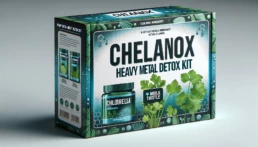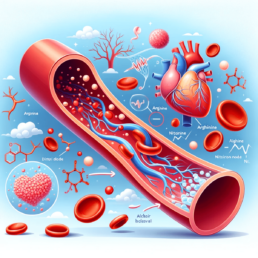Top 5 Mercury Detox Supplements
Mercury detox supplements that work. Our top five guide to the best of the best ingredients.
Why You Need Mercury Detox Supplements
Understanding how mercury enters your body is crucial. It’s empowering to know that by identifying these sources, you can take steps to reduce your exposure. Let’s explore the most common sources of mercury that most people encounter.
- Seafood
- Pesticides
- Dental Amalgams
- Cosmetics
Here are some practical tips on the sources mentioned above. Vary your seafood intake to avoid overexposure. Wash your fruits and veggies to remove pesticide residue. Consider replacing your dental amalgams. Opt for high-quality cosmetics. This article is not about avoidance but about effective detox. We believe in your capability to make these changes.
EDTA
EDTA, or Ethylenediaminetetraacetic acid, is a chelating agent used in various medical and consumer products as well as mercury detox supplements. When in capsule form, specially designed with acid resistance, EDTA serves specific health related purposes, including detoxifying heavy metals like mercury from the body. Here’s a closer look at how it works, its safety, and the importance of acid resistant capsules.
How EDTA Works
EDTA binds to heavy metals and minerals in the bloodstream, forming a complex that can be excreted from the body. This process is known as chelation. EDTA can help reduce the body’s heavy metal burden by binding to metals like mercury.
Safety of EDTA
EDTA is generally considered safe. It has been used for many years in a medical setting and sold to individuals as a supplement. It’s use in mercury detox supplements is safe and recommended.
Acid Resistance Capsules
The use of acid resistant capsules for EDTA is crucial for several reasons:
- Targeted Release: Acid resistant capsules ensure that EDTA is released in the intestines rather than the stomach. This targeted release maximizes the absorption of EDTA, enhancing its effectiveness in binding with heavy metals like mercury.
- Protection from Stomach Acid: EDTA is sensitive to the stomach’s acidic environment. Acid resistant capsules help by protecting EDTA from being broken down by stomach acid, ensuring that sufficient amounts reach the intestines for absorption.
- Improved Tolerance: Delivering EDTA to the intestines reduces the risk of stomach irritation or discomfort, which might occur if EDTA is released in the stomach.
Why It’s Used for Mercury Detox
Mercury is a toxic heavy metal that can accumulate in the body, leading to various health issues. EDTA can effectively bind to mercury, facilitating its removal from the body. This detoxification process can help mitigate the harmful effects of mercury exposure.
Our Chelanox product uses acid resistant capsules and has an effective yet safe dosage of EDTA. You can learn more about it here.
Cilantro Leaf Extract
If you like Mexican, Indian, or Thai foods, you have probably tried cilantro leaf. I love it with Pho soup.
Cilantro leaf extract comes from the leaves of the Coriandrum sativum plant ( Cilantro ). It is popularly used in detoxification processes, particularly in those used for removing heavy metals like mercury from the body. The natural properties of cilantro facilitate the binding to and removal of certain toxins, like mercury, making it a favored choice in natural health circles. Here’s an in depth look at how it works, its safety, and its mechanism of action in detoxifying mercury.
How Cilantro Leaf Extract Works
Cilantro has a unique ability to chelate or bind heavy metals thanks to certain chemical compounds it contains, such as linalool and polyphenolic compounds. These compounds can bind to heavy metals in the bloodstream, transforming them into more accessible forms for the body to excrete.
Safety of Cilantro Leaf Extract
Most people generally consider cilantro leaf extract safe when they consume it in the amounts typically found in food.Similarly, taking it as a supplement in moderation and according to most product guidelines also ensures its safety. Millions of people in Latin America consume cilantro daily, and billions worldwide use coriander, its seed, making it exceedingly safe.
Detoxification of Mercury
Cilantro attributes its detoxifying effect on heavy metals, particularly mercury, to its chelation capacity. Mercury can accumulate in the body from various sources, including certain fish, dental amalgams, and industrial exposure. Over time, mercury accumulation can lead to significant health issues. Cilantro helps mobilize mercury from tissue stores, facilitating its elimination from the body through natural detoxification pathways such as urination and defecation.
Why No Need for Acid Resistance Capsules
Unlike certain supplements like EDTA, cilantro leaf extract does not necessarily require acid resistant capsules for effective delivery. Cilantro and its active compounds are naturally resistant to stomach acids and can be absorbed efficiently in the gastrointestinal tract. When combined with EDTA, however, you still want the acid resistance, so they both work together.
Cilantro leaf extract is a crucial component of Chelanox.
Alpha Lipoic Acid
Alpha lipoic acid (ALA) plays a significant role in brain health, thanks partly to its ability to cross the blood brain barrier. This key factor allows it to aid in brain detoxification. This unique property makes ALA particularly effective in neutralizing harmful substances within the nervous system, including heavy metals like mercury, which can accumulate and cause cognitive and nervous system issues. You can buy it in black, but I don’t recommend it! It tastes horrible and is acidic because, well, it’s acid! You definitely want to take ALA in capsule form.
ALA and Brain Detox
- Crossing the Blood Brain Barrier: ALA can enter the brain due to its small size and fat solubility, allowing it to act directly on brain cells and tissues.
- Antioxidant Protection: In the brain, ALA helps to neutralize oxidative stress, which is critical because the brain is particularly vulnerable to oxidative damage due to its high oxygen consumption and lipid-rich environment.
- Chelation of Heavy Metals: ALA binds to metals such as mercury in the brain, transforming them into compounds that can be more easily excreted. This process reduces the toxic load on brain cells, helping to preserve their function and prevent damage.
- Regeneration of Other Antioxidants: By regenerating other essential antioxidants, such as glutathione, ALA enhances the brain’s overall capacity to detoxify and protect itself from oxidative stress and damage.
ALA’s Benefits for Brain Health
Beyond detoxification, ALA’s antioxidant properties contribute to brain boosting ability, potentially offering benefits against brain diseases and cognitive decline. Its role in energy metabolism further supports brain health, maintaining neural function and integrity.
Utilizing ALA for Brain Detox
For those interested in utilizing ALA for its brain detoxification properties, incorporating it into a daily supplement routine can offer a practical approach to leveraging its benefits. Given its capacity to support brain health through detoxification and beyond, ALA represents a valuable addition to a holistic approach to wellness and cognitive function preservation.
Milk Thistle
Milk thistle, or Silybum marianum, has earned its reputation for supporting and detoxifying the liver. However, its benefits go far beyond just aiding liver health. The active compound, silymarin, is behind many of its acclaimed effects. This plant doesn’t only work on liver detox but also offers significant protective and therapeutic advantages for the brain. Because of this connection it is gaining recognition in the realms of nutrition and herbal supplements. By increasing levels of glutathione, a potent antioxidant, milk thistle enhances the body’s detoxification capabilities, showcasing its versatile and far reaching health benefits.
How Milk Thistle Works
- Liver Support: Milk thistle primarily supports liver function, as mentioned earlier, which is crucial for detoxifying the blood and removing harmful substances from the body, including heavy metals and toxins that can affect brain health.
- Antioxidant Activity: Silymarin acts as a potent antioxidant, neutralizing free radicals that can damage cells and tissues throughout the body, including the brain.
- Neuro Protection: By reducing oxidative stress and inflammation, milk thistle helps protect brain cells from damage. This action is beneficial for maintaining cognitive functions and preventing degenerative diseases of the nerves.
Milk Thistle and Brain Detox
The liver’s role in detoxification is critical for overall health and directly impacts brain function. Toxins that the liver fails to eliminate can end up in the bloodstream. They can then cross the blood brain barrier, contributing to cognitive decline and nervous system diseases. Milk thistle supports liver health, thereby supporting brain detoxification by:
- Enhancing Liver Detoxification Capabilities: Improving liver health enhances its capacity to filter and remove toxins from the blood before they can reach and harm the brain.
- Reducing Inflammation: Chronic inflammation can impair both liver and brain function. Milk thistle’s anti abinflammatory properties support the health of these organs and their ability to detoxify.
- Supporting Glutathione Production: Milk thistle can increase glutathione levels and is a critical antioxidant in detoxification processes within the liver and brain. Higher glutathione levels enhance the body’s ability to neutralize and remove toxins.
Utilizing Milk Thistle for Brain Health
Incorporating milk thistle into a daily regimen can be a strategic approach to enhance brain health by supporting liver function and direct neuro protective effects. It’s commonly available in capsules, tablets, and liquid extracts, making it accessible for those looking to help their body’s natural detoxification processes.
In summary, these ingredients are just some of the few important chlating agents and supportive substances you can use to help you do a detox. We have incluced them all in Chelanox.
What’s In Chelanox?
EDTA
Chlorella Algae
Modified Citrus Pectin
Cilantro Leaf Extract 4:1
Shilajit 10:1 Extract
Zeolite
NAC (N-Acetyl Cysteine)
Alpha Lipoic Acid
Uva Ursi Leaf Powder
Milk Thistle Seed Powder
Each ingredient in Chelanox has been chosen to support the body’s natural detoxification processes, helping to bind and neutralize toxins, promote their excretion, and protect the body from their harmful effects. These ingredients work in synergy to offer a comprehensive approach to detoxification.
You can find Chelanox here.
Five Incredible Nitric Oxide Boosting Meals

Incorporating nitric oxide boosting meals into your diet can significantly enhance your health and fitness goals. Nitric oxide, a vital molecule your body produces, plays a crucial role in cardiovascular health by improving blood flow and reducing blood pressure. This article highlights five incredible meals that are not only delicious but also increase your body’s nitric oxide levels, promoting overall well-being.
1. Beetroot Salad with Citrus Dressing
Beetroot is an awesome powerhouse known for increasing nitric oxide levels in the body. This vibrant vegetable is rich in nitrates, which convert to nitric oxide. Combine beetroot with a citrus dressing made from lemon or orange to add a dose of Vitamin C. Vitamin C enhances nitric oxide production. For this delicious salad, mix sliced beets with your favorite greens, sprinkle with nuts for extra crunch, and drizzle with a citrus-based dressing. It’s a refreshing meal that boosts your nitric oxide levels. If you add arugula, you get even more nitrates! Be aware than not all commercially available beets have high nitrate counts, so it’s best to buy different types of beets and to include arugula to ensure higher nitrate concentration.
2. Garlic-Infused Grilled Chicken
Garlic is well-known for its health benefits, including its ability to increase nitric oxide levels. We here at Bionox have not sung garlic’s praises enough of late, but they are certainly due!
Prepare a garlic-infused grilled chicken by marinating chicken breasts in a mixture of minced garlic, olive oil, lemon juice, and herbs. Garlic stimulates the production of nitric oxide synthase, the enzyme responsible for converting nitrates to nitric oxide. This meal is not only heart-healthy but also full of flavor.
If you are vegan, a great alternative is kimchi, you can easily just up the garlic in kimchi or other fermented veggie combinations to boost your nitric oxide!
Garlic boosts nitric oxide levels through its high content of nitrates and a compound called allicin. When you eat some garlic, its compounds interact with red blood cells and trigger the production of nitric oxide synthase.
This enzyme is crucial for the conversion of dietary nitrates into nitric oxide (NO). Nitric oxide, in turn, plays a vital role in regulating blood flow, oxygen delivery, and blood pressure by dilating blood vessels. Additionally, garlic’swell known antioxidant properties may help protect nitric oxide molecules from oxidative damage, enhancing their stability and function in the body. In other words, antioxidants make nitric oxide stronger and last longer in the body. They are supportive to boosting nitric oxide.
This makes garlic an effective and natural way to increase nitric oxide levels, promoting cardiovascular health and overall well-being.
3. Arugula and Avocado Smoothie
Arugula is another nitrate-rich vegetable that boosts nitric oxide production. Combine it with avocado, which contains healthy fats that aid in nitric oxide absorption. Blend arugula, avocado, a banana for sweetness, and almond milk for a creamy texture. This green smoothie is a nutrient-packed meal that will increase your nitric oxide levels and keep you energized throughout the day.
Healthy fats, like those found in avocados, play an important role in boosting nitric oxide absorption and bioavailability in the body. The mechanism is slightly indirect though.
Monounsaturated Fats
Avocados are rich in monounsaturated fats, which have been shown to support cardiovascular health in various ways. One way we know if is through the improvement of endothelial function, which is the function of the inner lining of blood vessels. Good function means your body is producing more NOS, which is super important!
Healthy endothelial cells are vital for the production and maintenance of nitric oxide. If your arteries and veins are all gunked up with plaque for example, they can’t produce or deal well with nitric oxide.
Efficient Nitric Oxide Production
When the endothelium is healthy, it can produce nitric oxide more efficiently. Nitric oxide is a vasodilator, meaning it helps to relax and expand blood vessels. It opens up your veins thus improving blood flow and reducing blood pressure. Furthermore, the monounsaturated fats in avocados can help reduce inflammation and oxidative stress, both of which can damage the endothelium and impair its ability to produce nitric oxide. As a side note here, seed based oils do the opposite! They increase inflammation so avoid them if you can!
Studies
Studies have linked the consumption of avocados and other sources of healthy fats with cardiovascular benefits, including enhanced endothelial function and lower levels of inflammation, though direct studies on avocados and nitric oxide absorption are more nuanced and typically focus on the broader impacts of diet on nitric oxide levels and cardiovascular health.
4. Walnut-Crusted Salmon
Omega-3 fatty acids in salmon work synergistically with nitric oxide to improve blood flow. Coating salmon with crushed walnuts adds a crunchy texture and supplies additional L-arginine, a precursor to nitric oxide. Season the salmon with herbs and spices of your choice, crust it with crushed walnuts, and bake. This meal is a delicious way to boost your nitric oxide levels and support heart health at the same time!
5. Dark Chocolate Oatmeal
Dark chocolate is not only a treat for your taste buds but also beneficial for nitric oxide levels. It contains flavonoids that stimulate nitric oxide production. Prepare a bowl of oatmeal and add dark chocolate chunks, berries, and a sprinkle of chia seeds for an antioxidant.
Chocolate Is Now Officially Good For You
The FDA has announced that it will not object to certain qualified health claims about the consumption of cocoa flavanols in high flavanol cocoa powder and its association with a reduced risk of cardiovascular disease. Cocoa is another name for Chocolate in case you didn’t know.
This approval is contingent on the claims being accurately worded to avoid misleading consumers and meeting other specified conditions. The health claims are based on scientific evidence connecting cocoa flavanols to cardiovascular health benefits. The qualified health claim is specific to high flavanol cocoa powder and does not apply to regular cocoa powder or chocolate products.
Glyphosate Detox A Natural Approach
Glyphosate Detox: what is Glyphosate, and why detox from it?
Glyphosate stands as the active ingredient in many of today’s widely utilized herbicides. Farmers apply it to food crops on a massive scale. It commonly finds its way into everything we eat, drink, and sometimes even breathe. Glyphosate works by targeting a specific chemical pathway essential for a plant’s growth. Many regulatory agencies deem it safe for human use, but research and debates continue regarding its safety profile. The World Health Organization’s International Agency for Research on Cancer classified glyphosate as “probably carcinogenic in humans.” This is based on evidence linking it to non-Hodgkin’s lymphoma and other health issues. Therefore, it’s safe to say that you do not want this junk in your body, and finding effective ways to mitigate glyphosate exposure is becoming increasingly important.
So What is Glyphosate?
Many of today’s commonly used herbicides contain glyphosate as their active ingredient. If your spray bottle kills weeds, glyphosate likely serves as the active component.
For years, glyphosate has occupied the center of environmental and health discussions, often intertwining with GMO debates, health concerns, cancer, and numerous lawsuits.
Undoubtedly, glyphosate is the world’s most frequently used weed killer. Its widespread use in agriculture and gardening has sparked concerns about its potential health effects. Farmers use it on food crops extensively, leading to its presence in almost everything we eat, drink, and sometimes even breathe. Understanding Glyphosate Detox mechanisms and strategies therefore is extremely important.
Given these concerns, the importance of finding effective ways to mitigate glyphosate exposure is increasing. Therefore, we feel the need to provide our customers with more information to satisfy their growing interest in natural detoxification methods.
Understanding Glyphosate and Its Risks
Glyphosate works by targeting a specific chemical pathway essential for a plants growth. While deemed safe for human use by many regulatory agencies ( highly suspect ), research and debates continue regarding its safety profile. Concerns have been raised about its potential as an endocrine disruptor, its role in antibiotic resistance, and its association with certain health conditions. The World Health Organization’s International Agency for Research on Cancer classified glyphosate as “probably carcinogenic in humans” based on evidence linking it to non-Hodgkin’s lymphoma and other health issues.
So, because of all this information and the plethora of studies linking glyphosate to diseases and also bad agricultural practices, it’s safe to say, you do not want this junk in your body.
Potential Adverse Effects of Glyphosate: Why Do A Glyphosate Detox?
Human Health Concerns:
- Increased risk of cancer, specifically non-Hodgkin lymphoma, according to some studies.
- Disruption of human hormonal functioning, potentially affecting reproductive health.
- Damage to cellular DNA and potential to cause cellular changes that could lead to major health issues.
- Negative impacts on gut bacteria, possibly leading to digestive problems and affecting overall health.
- Skin and eye irritation upon direct contact.
Environmental Impact:
- Reduction in biodiversity, with harmful effects on various plant species and disruption of habitats.
- Potential harm to non-target organisms, including beneficial insects like bees and butterflies, affecting pollination.
- Contamination of water sources due to runoff, affecting aquatic life and potentially entering human drinking water supplies.
- Development of glyphosate-resistant weeds, leading to increased use of herbicides and further environmental stress.
Agricultural Concerns:
- Soil health degradation over time, affecting soil structure and nutrient availability.
- Impact on the microbial balance in the soil, potentially reducing the effectiveness of natural pest and disease control mechanisms.
- Risk of glyphosate residue in food, raising concerns about long-term consumption safety.
The Body’s Battle Glyphosate’s Impact
Exposure to glyphosate, whether through dietary consumption of treated or contaminated crops, may severely affect human health.
One way to do so is to disrupt your gut bacteria. This begins by impairing enzymatic functions, contributing to toxicity in various organs. These disturbances can lead to a cascade of health issues.
You Need Good Bacteria
Glyphosate disrupts gut bacteria ( commonly known as probiotics ) by impairing the enzymatic functions necessary for their survival and growth. In other words, it starves them and stops their ability to live, function, and reproduce.
Probiotics are live microorganisms that, when administered in adequate amounts, are healthy and necessary. They are often referred to as “good” or “beneficial” bacteria because they help maintain a healthy gut. This is one of the reasons you will see probiotics as a main section of supplements at every health food store on the planet. They are vital to good health.
Glyphosate Detox: A Path to Mitigation
Growing concern over glyphosate has brought natural ingredients like modified citrus pectin (MCP), chlorella, and cilantro to the forefront as potential allies in detoxification from glyphosate. Research has shown that these substances can protect against heavy metals and toxins, including glyphosate, by various mechanisms.
Modified Citrus Pectin (MCP): Derived from the peel and pulp of citrus fruits, MCP has a unique ability to bind to heavy metals and toxins, helping to excrete them from the body without depleting essential minerals. Its capacity to bind potentially traps the glyphosate molecule, thereby reducing glyphosate’s bioavailability and toxic impact.
Chlorella: Known for its detoxification properties, this freshwater green algae, rich in chlorophyll, vitamins, and minerals, supports the body’s natural detox pathways in eliminating toxins. Chlorella’s high chlorophyll content effectively binds with and removes heavy metals, a mechanism potentially useful in glyphosate detoxification.
Cilantro: Traditional medicine practices have long used cilantro for its detoxifying effects. Its compounds may latch onto toxic metals, aiding in their removal from the body. Cilantro could help cleanse the body of glyphosate, though further research is needed to understand the specific mechanisms.
Incorporating Natural Detox into Daily Living
Adopting a diet rich in these natural detoxifiers can be a proactive step toward minimizing glyphosate’s health risks. Incorporating MCP supplements, adding chlorella to smoothies, and using fresh cilantro in cooking are practical ways to leverage their potential detoxifying effects.
It’s essential to approach detoxification with a holistic mindset. Because focusing on a balanced diet is so important, some people forget about adequate hydration! Always hydrate! Regular exercise is also key to supporting the body’s natural detox pathways.
Natural detoxification methods offer a promising avenue for reducing the potential health impacts of glyphosate. Modified citrus pectin, chlorella, and cilantro represent a natural approach to supporting the body’s detoxification processes, highlighting the power of nutrition in defending against environmental toxins.
In the quest for optimal health in a world where chemical exposure is an ever-present reality, turning to nature’s pharmacy for detoxification support not only empowers you but also underscores the importance of environmental stewardship and the need for safer agricultural practices.
The Comprehensive Guide to EDTA Chelation: Detoxifying Heavy Metals and Reducing Arterial Calcification

EDTA chelation therapy has been a subject of medical research and practice for several decades. Initially it was used for lead detoxification in the mid-20th century. Because of this, its application has expanded to address various health issues, including cardiovascular diseases and heavy metal poisoning.
This article explores the history, mechanisms, and benefits of EDTA chelation therapy. It focuses on its role in detoxifying heavy metals and reducing arterial calcification, as well as its potential as an oral supplement.
Because of rampant contamination in our food, water and the air we breathe, understanding how to use EDTA is more important than ever!
History of EDTA Chelation
EDTA (ethylene diamine tetra-acetic acid) was first synthesized in the 1930s and gained prominence during World War II as a treatment for lead poisoning among factory workers. Its ability to bind with metal ions and form stable compounds made it an effective agent for removing heavy metals from the body.
After the war, researchers began investigating its potential in treating atherosclerosis and other cardiovascular conditions.
Mechanism of Action
EDTA chelation therapy works by binding to heavy metals in the bloodstream, such as lead, mercury, and cadmium. It forms complexes that are then excreted in the urine. This process effectively reduces the body’s toxic metal burden. Beyond heavy metal detoxification, EDTA has been observed to have a decalcifying effect on arterial walls by removing calcium deposits, which are a key component of arterial plaque.
Detoxifying Heavy Metals
Heavy metals accumulate in the body from various sources, including environmental pollutants, occupational exposure, and contaminated food and water. These metals can disrupt biological processes and increase oxidative stress, leading to chronic diseases. EDTA chelation therapy has been shown to effectively reduce levels of these toxic metals, thereby mitigating their adverse health effects.
Reducing Arterial Calcification
Calcification in the arteries is a hallmark of atherosclerosis, which can lead to cardiovascular diseases such as heart attack and stroke. By chelating calcium, EDTA helps reduce arterial plaque and improve blood flow. Clinical trials, including the TACT (Trial to Assess Chelation Therapy), have provided evidence supporting the cardiovascular benefits of EDTA chelation therapy.
EDTA as an Oral Supplement
While intravenous administration is the most common form of EDTA chelation therapy, oral EDTA supplements have also become available. Oral chelation offers a less invasive option, with studies suggesting its efficacy in heavy metal detoxification and cardiovascular health improvement. However, the absorption and effectiveness of oral EDTA can vary.
Potential Benefits and Considerations
Sexual Function: Improved blood flow as a result of reduced arterial calcification. This could potentially enhance sexual function, given the critical role of circulation in sexual health.
Overall Health: By reducing the body’s burden of heavy metals and improving cardiovascular health, EDTA chelation therapy may contribute to a greater sense of well-being and vitality.
Safety and Side Effects: EDTA chelation therapy is generally considered safe when performed under medical supervision. Potential side effects may include kidney damage and mineral deficiencies.
Conclusion
EDTA chelation therapy offers a multifaceted approach to improving health by detoxifying heavy metals and reducing arterial calcification. Its history, from treating lead poisoning to potentially enhancing sexual function and cardiovascular health, illustrates its versatility and therapeutic potential.
Arginine While Fasting: Unlocking the Benefits
Unlocking the Benefits of Arginine While Fasting for Weight Loss and Enhanced Autophagy.
Fasting has emerged as a transformative approach to weight loss and improved health. This is done through its role in promoting autophagy. Autophagy is the body’s natural process of cleaning out damaged cells and regenerating new ones. As individuals seek to maximize the benefits of fasting, the role of amino, especially arginine, becomes important. Arginine is not just a buzzword but a concept worth a topic of keen interest exploring. Anyone looking to enhance their fasting results, particularly for weight loss and autophagy can benefit from this information.
Understanding Arginine Role
Arginine, a semi-essential amino acid, plays a critical role in various bodily functions. This includes the production of nitric oxide, which improves blood flow and nutrient delivery throughout the body. During fasting, arginine levels can become limited. Intriguingly, this may benefit the fasting process by pushing the body to turn to its internal energy reserves. This helps by accelerating weight loss and potentially enhancing the autophagy process.
Weight Loss and Arginine
Fasting triggers the body to search for alternative energy sources, typically turning to stored fats, which leads to weight loss. Arginine supplementation during fasting presents a paradox. It is beneficial for its health properties, its availability might reduce the body’s need to tap into these fat reserves. However, understanding the balance between supplementation and natural body processes is key. For those fasting with the goal of weight loss, the strategic use of arginine could potentially support metabolic health without significantly disrupting the fasting-induced metabolic shift.
Boosting Autophagy with Arginine
Autophagy, a vital cellular cleanup process, is one of the most sought-after benefits of fasting. It plays a crucial role in cell health, aging, and the prevention of diseases. The question arises: does arginine supplementation affect autophagy during fasting? While the direct impact of arginine on autophagy during fasting requires more research, it’s clear that maintaining a balance is essential. Properly timed arginine supplementation could support the body’s natural processes without hindering the autophagic benefits of fasting.
Arginine’s Potential Impact on Autophagy
- Nutrient Sensing and Autophagy: Fasting triggers autophagy by creating a nutrient scarcity, signaling the body to start cellular cleanup. Arginine supplementation during fasting could alter nutrient-sensing pathways, affecting autophagy.
- mTOR Pathway Activation: Arginine activates the mTOR pathway, which can inhibit autophagy by increasing protein synthesis. Fasting aims to reduce mTOR activity to boost autophagy, so arginine might counter this effect.
- Benefits versus Drawbacks: Although arginine offers health benefits, its supplementation during fasting periods requires careful consideration. Timing arginine intake correctly could manage its impact on autophagy.
Fasting and Arginine Supplementation Considerations
- Align Supplementation with Health Goals: Individuals should tailor their supplementation strategy to their health goals. Minimizing arginine during fasting may be wise for those focusing on autophagy.
- Time Supplementation Wisely: Taking arginine outside of fasting periods may allow individuals to enjoy its benefits without affecting autophagy.
- Seek Expert Advice: Consulting with healthcare or nutritional experts is crucial due to the complexity of fasting, autophagy, and amino acid supplementation.
Arginine supplementation offers various health benefits but may influence autophagy during fasting. For those aiming to enhance autophagy through fasting, considering the timing and amount of arginine supplementation is important. By understanding these biological mechanisms, individuals can make informed decisions to optimize their health outcomes, balancing the benefits of fasting and arginine supplementation.
Practical Tips for Incorporating Arginine During A Fast
- Timing is Key. Consider the timing of arginine supplementation to ensure it aligns with your fasting goals. For those focusing on weight loss and autophagy, taking arginine outside of the fasting window can offer the benefits. This is done without interfering in the fasting process.
- Monitor Your Progress. Keep track of your fasting outcomes and how supplements like arginine affect your weight loss and overall health. Adjustments can always be made to optimize results.
- Balance Your Diet. During your eating windows, focus on a balanced diet rich in nutrients to support your body’s needs. Including natural sources of arginine, such as nuts, seeds, and legumes is key.
To Summarize
Arginine during a fast is a nuanced topic with the potential to enhance the fasting experience, particularly for individuals focused on weight loss and autophagy. By understanding and respecting the delicate balance between supplementation and the natural fasting process, it’s possible to achieve optimal health outcomes.
Whether you’re a seasoned faster or just beginning your journey, the integration of arginine into your regimen requires thoughtful consideration to truly unlock the benefits of fasting.
Types Of Arginine And Health Benefits

The Types Of Arginine are important to know because each type can offer slightly different benefits. Lets dive deeper and find out why.
L-Arginine plays a pivotal role in numerous physiological processes, offering various health benefits. It supports blood pressure, circulation, and offers many health benefits.
Its different forms cater to specific needs, so some enhance its overall effectiveness and some its bioavailability. Let’s delve into the details of each type and how they are made.
L-Arginine HCl (Hydrochloride)
L-Arginine HCl (Hydrochloride) is a variant of the amino acid L-Arginine. It is crucial for several bodily functions. The list is large, including protein synthesis, ammonia detoxification, and the production of nitric oxide. The key difference between L-Arginine HCl and regular L-Arginine lies in their composition and solubility.
Differences from Base Arginine
- Composition: L-Arginine HCl combines L-Arginine with a hydrochloride molecule. This addition helps to stabilize the arginine, making it more palatable and increasing its solubility in water.
- Solubility: The primary advantage of L-Arginine HCl over base arginine is its enhanced solubility. This feature makes it easier to consume in liquid form and potentially improves its absorption in the digestive system.
- Taste: The hydrochloride form is generally considered to have a more tolerable taste comparing it to the base form, which is quite bitter.
Uses and Preferences
L-Arginine HCl is known for its various uses, particularly in areas related to cardiovascular health, athletic performance, and recovery from injuries or surgeries:
- Cardiovascular Health: Due to its role in nitric oxide production, L-Arginine HCl is often used to support cardiovascular functions. This includes improving blood flow and reducing blood pressure.
- Athletic Performance: Athletes may prefer L-Arginine HCl. It has strong potential for improving blood flow and oxygen delivery to muscles during intense workouts. It is good for enhancing performance and recovery.
- Wound Healing: Its ability to improve circulation also makes L-Arginine HCl a candidate for supporting faster wound healing.
Choosing L-Arginine HCl over Other Forms
The choice between L-Arginine HCl and other forms of L-Arginine often depends on the specific needs and preferences. Also important are potential sensitivities people may have:
- Digestibility and Absorption: Those who might have sensitivity to the base form or require a more easily absorbed variant may opt for L-Arginine HCl due to its enhanced solubility.
- Specific Health Goals: L-Arginine HCl might be preferred for cardiovascular support or to enhance exercise performance, where rapid absorption and efficacy are desired.
- Taste Preferences: The less bitter taste of L-Arginine HCl can make it a more palatable option for individuals who struggle with the taste of base L-Arginine supplements.
In summary, while all forms of L-Arginine provide similar fundamental benefits due to their role in nitric oxide production and protein synthesis, the choice of L-Arginine HCl over others might be influenced by its solubility, absorption rate, taste, and specific health objectives. Always consulting with a healthcare provider before starting any new supplement regimen is advisable to ensure it aligns with your health needs and goals.
L-Arginine AKG (Alpha-Ketoglutarate)
Arginine AKG (Alpha-Ketoglutarate) combines the amino acid L-Arginine with Alpha-Ketoglutarate, a crucial molecule in the Krebs cycle, responsible for energy production. This blend offers unique benefits over base L-Arginine and other Arginine forms.
Differences from Base Arginine
- Composition: The key difference lies in Alpha-Ketoglutarate’s addition to L-Arginine, enhancing the compound’s role in amino acid synthesis and energy generation.
- Absorption and Effectiveness: The body absorbs and utilizes L-Arginine AKG more efficiently than base L-Arginine. Alpha-Ketoglutarate increases L-Arginine’s stability and bioavailability.
- Energy Production: L-Arginine AKG’s involvement in the Krebs cycle makes it highly effective in boosting energy, offering significant benefits for energy-demanding activities.
Uses and Preferences
L-Arginine AKG is particularly popular for specific uses, mainly in the realms of athletic performance and recovery:
- Enhanced Athletic Performance: Athletes and bodybuilders often choose L-Arginine AKG for its superior ability to boost nitric oxide production, enhancing blood flow, oxygen delivery to muscles, and overall performance.
- Supports Muscle Recovery: The compound aids in quicker muscle recovery post-intense workouts by improving nutrient delivery to muscles.
- Energy Boost: People looking for an energy increase during physical activities benefit from L-Arginine AKG, thanks to its critical role in the energy production cycle.
Choosing L-Arginine AKG over Other Forms
Choosing L-Arginine AKG over other Arginine forms usually aligns with specific goals, especially concerning physical performance and energy needs:
- For Athletic Performance and Recovery: Individuals aiming to maximize physical performance and enhance muscle recovery might find L-Arginine AKG more suitable due to its nitric oxide production and absorption benefits.
- For Energy Enhancement: Those in need of an energy uplift for workouts or athletic endeavors may prefer L-Arginine AKG for its direct involvement in energy production.
L-Arginine Aspartate
Arginine Aspartate stands out from L-Arginine AKG and base L-Arginine due to its unique combination and specific applications:
Unique Characteristics of L-Arginine Aspartate
- Aspartate Component: Unlike AKG, which is involved in the Krebs cycle and energy production, aspartate plays a critical role in the urea cycle. It is adept at helping to eliminate excess nitrogen from the body. This function of aspartate can enhance endurance by efficiently removing ammonia. Ammonia is a byproduct of exercising muscle, thus potentially reducing fatigue.
- Neurotransmitter Support: Aspartic acid acts as a neurotransmitter in the brain. This can influence the production of testosterone, enhancing hormone levels that are crucial for muscle mass and strength. This aspect differentiates it from L-Arginine AKG, which does not directly influence neurotransmitter levels or hormone production.
- Enhanced Endurance and Recovery: Both AKG and aspartate forms are known for their potential to enhance athletic performance,. L-Arginine Aspartate however, specifically offers benefits related to endurance and recovery. This is due to its role in ammonia detoxification.
Applications and When to Use L-Arginine Aspartate
- For Enhanced Endurance Sports Performance: Due to its efficient role in ammonia detoxification, individuals engaged in endurance sports might prefer L-Arginine Aspartate to support longer periods of physical activity and to reduce recovery time.
- When Seeking Hormonal Support: Those looking into natural ways to support hormone production, particularly testosterone, might find L-Arginine Aspartate beneficial due to the neurotransmitter role of aspartic acid.
- For Comprehensive Athletic Support: Athletes focusing on both performance and recovery, especially in sports that demand high endurance, might choose L-Arginine Aspartate over AKG or base L-Arginine for its dual action in energy metabolism and detoxification.
In contrast to L-Arginine AKG, which is often chosen for its direct benefits on energy production and nitric oxide synthesis, L-Arginine Aspartate offers a broader spectrum of support, particularly beneficial for endurance and recovery, making it a distinct choice for athletes and individuals seeking specific health benefits.
L-Arginine Malate
Arginine Malate is a compound that combines L-Arginine with Malate, a tricarboxylic acid cycle (TCA cycle or Krebs cycle) intermediate. This combination offers distinct advantages and uses compared to other forms of L-Arginine.
Differences and Unique Benefits of L-Arginine Malate
- Enhanced Energy Production: Malate plays a crucial role in the Krebs cycle, a key energy-producing process in the body. L-Arginine Malate, therefore, not only boosts nitric oxide levels but also supports energy production at a cellular level. Therefore making it particularly beneficial for endurance and performance.
- Improved Athletic Performance: Due to its dual role in enhancing nitric oxide production and supporting the Krebs cycle, L-Arginine Malate is often chosen by athletes. They choose it seeking to improve their performance, endurance, and recovery times.
- Support for Aerobic and Anaerobic Metabolism: The presence of Malate supports both aerobic (with oxygen) and anaerobic (without oxygen) energy pathways, offering a versatile energy boost that can be beneficial across different types of physical activities.
Contrast with Other Forms of L-Arginine
- L-Arginine HCl: While L-Arginine HCl is primarily sought after for its improved solubility and absorption, L-Arginine Malate offers the added benefit of supporting energy production, making it a more suitable choice for individuals looking to enhance physical performance and energy levels.
- L-Arginine AKG: Although L-Arginine AKG is also known for its role in energy production and nitric oxide synthesis, L-Arginine Malate might be preferred for activities that require sustained energy over longer periods, due to the efficient role of Malate in the Krebs cycle.
- Base L-Arginine: The base form of L-Arginine primarily serves to increase nitric oxide production. However, L-Arginine Malate extends beyond this by also enhancing energy production, offering a broader range of benefits for physical activity and performance.
When to Use L-Arginine Malate
- Endurance Athletes: Individuals engaged in long-duration sports or activities may find L-Arginine Malate particularly beneficial for its dual role in boosting nitric oxide levels and supporting sustained energy production.
- Those Seeking Enhanced Recovery: The improved blood flow from increased nitric oxide production, combined with efficient energy metabolism, can help facilitate quicker recovery after intense workouts.
- Individuals Focused on Aerobic and Anaerobic Performance: L-Arginine Malate’s support for both energy pathways makes it an excellent choice for athletes who engage in a mix of aerobic and anaerobic exercises.
In summary, L-Arginine Malate offers unique benefits that make it stand out from other forms of L-Arginine, especially for athletes and individuals seeking to improve their energy levels, performance, and recovery. Its ability to support nitric oxide production and energy metabolism simultaneously provides a comprehensive approach to enhancing physical performance.
In essence, L-Arginine AKG stands out for individuals focused on sports performance. It’s great for recovery, and energy thanks to its enhanced bioavailability and contribution to energy metabolism. Each of these forms of L-Arginine is designed to optimize the amino acid’s benefits. Whether used for improving cardiovascular health, enhancing athletic performance, or supporting overall well-being. The choice of form can depend on the desired effect, the method of delivery, and individual tolerance.
Heavy Metal Detox Kit
Heavy Metal Detox Kit: Unveil the Power with Chelanox
In the modern environment, heavy metals infiltrate our bodies from sources like pollution, food, and water. These toxins can accumulate so they pose grave health risks. The heavy metal detox kit in capsule for “Chelanox” presents a comprehensive solution. This is because it combines natural ingredients, each selected for their detoxifying properties. Let’s delve into the ingredients that make Chelanox a potent choice for purging heavy metals from the body.
Chelanox Ingredients for Effective Heavy Metal Detox
EDTA: Ethylenediaminetetraacetic acid (EDTA) acts as a chelating agent, binding to heavy metals in the bloodstream to facilitate their removal. It efficiently targets metals such as lead, mercury, and arsenic, so we have made it a cornerstone of detox efforts.
EDTA Safety
Ethylenediaminetetraacetic acid (EDTA) is generally safe when used under medical supervision. It’s commonly used in chelation therapy to remove heavy metals from the bloodstream. However, it’s essential to use it correctly, as inappropriate doses can lead to adverse effects.
Chlorella Algae Safety
Chlorella Algae is considered safe for most people when consumed in recommended amounts. It’s rich in nutrients and has been used in supplements for detoxification. People with allergies to molds or a sensitivity to iodine should exercise caution.
Chlorella Algae: This green algae binds to heavy metals, aiding in their removal. Its high chlorophyll content boosts detoxification, making it a key ingredient in Chelanox.
Modified Citrus Pectin: Easily absorbed by the body, this form of pectin chelates heavy metals, supporting their excretion. It also enhances cellular health and immune function, offering benefits beyond detoxification.
Modified Citrus Pectin Safety
Modified Citrus Pectin is safe for most individuals when taken orally. It is derived from citrus peels and has been used in dietary supplements for its detoxifying properties. As with any supplement, following recommended doses is crucial to avoid digestive discomfort.
Cilantro Leaf Extract 4:1: Celebrated for its detoxifying capabilities, especially in mercury removal, cilantro’s concentrated extract amplifies these benefits in Chelanox.
Cilantro Leaf Extract Safety
This leaf is generally safe when consumed in food amounts. The extract is used for detoxification purposes. It should be taken according to product guidelines to avoid any potential side effects, such as allergic reactions in sensitive individuals.
Shilajit 10:1 Extract: Packed with fulvic acid, Shilajit boosts the body’s detox pathways, supporting toxin removal. Its inclusion enhances Chelanox’s effectiveness against heavy metal accumulation.
Shilajit Safety
This is a natural resin, is considered safe for most adults when taken in supplement form at recommended dosages. It’s important to source Shilajit from reputable suppliers, as low-quality products may contain harmful contaminants.
Zeolite: This mineral traps and removes heavy metals, thanks to its unique structure. It’s an excellent addition to Chelanox, contributing to its detox prowess.
Zeolite Safety
Zeolite supplements are safe for short-term use. Limited data exists on their long-term safety, so using zeolite with a healthcare provider’s guidance, especially for detox purposes, is advisable.
NAC (N-Acetyl Cysteine): As a precursor to glutathione, a potent detoxifier, NAC combats oxidative stress and aids the liver in eliminating heavy metals.
Alpha Lipoic Acid: This antioxidant aids the body’s detox processes because it rejuvenates other antioxidants, bolstering the fight against heavy metals.
Uva Ursi Leaf Powder: Supporting urinary tract health, Uva Ursi facilitates toxin elimination, including heavy metals, through the urinary system.
Milk Thistle Seed Powder: This herb enhances liver health so it is crucial for detoxification. It protects and regenerates liver cells, improving the body’s capacity to cleanse itself of toxins, including heavy metals.
Conclusion
Chelanox’s heavy metal detox kit excels with its blend of natural ingredients, each playing a role in the effective removal of heavy metals. Every element of Chelanox has designed to enhance detoxification and works in promoting health. Choosing Chelanox allows individuals to cleanse their bodies naturally and support overall well-being effectively.
Arginine and PAD
Arginine and PAD: A Comprehensive Overview
Arginine, an essential amino acid, plays a pivotal role in various bodily functions. The most well known role is in the regulation of blood pressure. Historically, researchers have studied its benefits, particularly those related to improving cardiovascular health.
Arginine’s works because of the synthesis of nitric oxide, a compound essential for opening your blood vessels, thereby reducing blood pressure. Studies, such as those published in the “Journal of Clinical Hypertension,” highlight its efficacy in managing hypertension, a common precursor to Peripheral Arterial Disease (PAD).
The Connection Between Arginine and PAD
Peripheral Arterial Disease is a condition where one has a narrowing of blood vessels and reduced blood flow. This is usually in the legs. The link between arginine and PAD stems from arginine’s ability to improve blood flow.
By enhancing nitric oxide production, arginine aids in dilating blood vessels, which is crucial for PAD patients. Research in the “American Heart Journal” supports the use of arginine supplementation, showing significant improvement in the symptoms of PAD, such as leg pain and walking distance.
Clinical Evidence Supporting Arginine for PAD
Clinical trials further make the case for arginine’s role in PAD management. A landmark study published in “Circulation” demonstrated that arginine supplementation led to marked improvements in endothelial function among PAD patients.
Participants reported enhanced walking ability and reduced symptoms, underscoring arginine’s potential as a therapeutic agent. Another study in the “European Journal of Cardiovascular Nursing” echoed these findings, noting improved quality of life in PAD patients following arginine supplementation.
The Future of Arginine in PAD Treatment
The growing body of evidence suggests a promising future for arginine in PAD treatment. As research continues to evolve, arginine’s role becomes increasingly significant. Healthcare professionals are beginning to recognize the amino acid’s value not only in managing PAD symptoms but also in offering a non-invasive treatment alternative. With further studies ahead for sure, arginine could become a cornerstone in PAD therapy, offering hope to those afflicted by this debilitating condition.
Arginine’s journey from a blood pressure regulator to a potential PAD treatment highlights its therapeutic powers. The amino acid’s ability to enhance nitric oxide production and improve vascular function positions it as an invaluable tool in combating PAD. Arginine stands out as a beacon of hope for millions suffering from cardiovascular diseases. It’s use promises a healthier, more active future for many.
How Can I Tell if Taking Arginine is Helping?
Determining the effectiveness of Arginine, especially for conditions like Peripheral Arterial Disease (PAD), involves observing specific health improvements. Consulting with healthcare professionals is also key. Here are a few things to watch for:
- Improved Circulation and Reduced Symptoms of PAD: Arginine can enhance blood flow, leading to noticeable improvements in symptoms associated with PAD. These can be things such as less pain during walking, increased walking distance without discomfort, and reduced symptoms of leg pain due to poor circulation.
- Enhanced Exercise Performance: As Arginine helps improve blood flow, you might find an improvement in your overall exercise habbits. This includes longer times of physical activity without fatigue and better recovery.
- Blood Pressure Changes: Arginine’s impact on nitric oxide production can lead to vasodilation. This is just a fancy way of saying “It opens your veins”. This helps in reducing blood pressure. Monitoring your blood pressure can provide tangible evidence of Arginine’s effects. A consistent decrease in readings may indicate its positive impact on your cardiovascular health.
- Consult Blood Tests: Blood tests can reveal changes in the levels of certain markers that indicate improved vascular health. One important one is reduced levels of LDL cholesterol and increased HDL cholesterol. Your doctor can help interpret these results and determine if Arginine is contributing to these changes.
- Professional Evaluation: Regular check-ups with your healthcare provider are vital. They can perform tests to assess the health of your blood vessels and heart, providing a professional perspective on whether Arginine is beneficial for you.
Remember, while these indicators can suggest Arginine’s effectiveness, individual responses may vary. It’s essential to use Arginine under medical supervision. Especially if you have pre-existing health conditions or are taking other medications. Always discuss with your healthcare provider before starting any new supplement to ensure it’s appropriate for your health needs.
Join Us To Learn More
Joining the Bionox newsletter and trying Ultimate Nitric Oxide Nutrition could be a game-changer for your health. This is especially true if you’re seeking to improve cardiovascular wellness and enhance overall vitality.
By subscribing below, you’ll gain exclusive access to the latest insights, health tips, and breakthroughs in nitric oxide research and nutrition. Ultimate Nitric Oxide Nutrition, crafted with precision, aims to harness the power of Arginine and other key nutrients to support optimal blood flow, energy levels, and nutrient delivery throughout your body.
This innovative approach not only targets the foundations of cardiovascular health but also empowers your body to perform at its best. Whether you’re looking to boost your exercise performance, improve circulation, Bionox offers the knowledge and nutritional solutions to guide you on your journey. Join the Bionox community today to start transforming your health with the power of nitric oxide nutrition.
6 Juices to Naturally Detox from Heavy Metals
Naturally Detox from Heavy Metals
Heavy metals, such as lead, mercury, and arsenic, can accumulate in our bodies over time. This can lead to a range of health issues. From cognitive problems to digestive disturbances, the impacts of heavy metal toxicity can be profound. Fortunately, certain dietary choices, including specific juices, can aid in the detoxification process. Juicing can help to cleanse your body of these harmful substances so it’s important to learn about them. This article explores six potent juices you can use and benefit from. These juices are not always delicious but they can play a crucial role in detoxifying the body from heavy metals.
Understanding Heavy Metal Toxicity
Heavy metals naturally occur in the environment, but excessive exposure can lead to accumulation in our bodies. This can pose significant health risks. These metals can enter our system through contaminated food, water, industrial exposure, and even beauty products. This accumulation can lead to symptoms such as fatigue, headaches, and more serious conditions like kidney dysfunction and neurological disorders.
The Role of Diet in Detoxification
Diet plays a pivotal role in supporting our body’s natural detoxification processes. Certain nutrients and foods can help you to naturally detox from heavy metals, with specific juices standing out for their detoxifying properties. These juices are rich in antioxidants, vitamins, and compounds that support liver function. They also aid in the chelation process (binding and removing metals), and bolster the immune system.
Juices for Heavy Metal Detox
Here’s a list of known juices that can aid in the removal of heavy metals. Each is accompanied by a brief overview of their benefits:
- Cilantro Juice: Cilantro is renowned for its chelating abilities, helping to bind heavy metals and facilitate their elimination from the body. A simple blend of fresh cilantro leaves with water can create a powerful detox juice.
- Wild Blueberry Juice: Wild blueberries are packed with antioxidants that support the detoxification process. This is particularly useful in cleansing the brain and liver.
- Chlorella Green Juice: Chlorella, a type of algae, is a potent detoxifier known for its ability to bind to heavy metals.
- Spirulina Drink: Spirulina is another algae with strong chelating properties, making it effective in heavy metal detoxification.
- Ginger and Lemon Juice: This combination not only boosts digestion but also supports liver function an essential organ.
- Beetroot and Apple Juice: Beetroot and apple both support liver health and detoxification, with beetroot particularly known for its blood-cleansing properties.
The Best Juices To Detox
Cilantro Juice
Benefits: Cilantro is a powerful herb for detoxing so we mention it first. It binds to heavy metals, aiding their removal from the body. This makes it a top choice for detox juices. Like a lot of the juices mentioned below, you probably do not want to juice it alone. It’s probably best to mix it with one of the other juices mentioned below!
Wild Blueberry Juice
Benefits: Wild blueberries are antioxidant-rich. They support the body in removing heavy metals, especially from the brain. They are delicious so try mixing them with the other plants mentioned here to make it all taste good!
Tips:
- Use fresh or frozen wild blueberries.
- Blend with a bit of water for a pure juice.
- Drink daily for best results.
Chlorella Green Juice
Benefits: Chlorella is a green algae with a high capacity for detoxification and it’s amazing! It binds to metals, facilitating their expulsion.
Spirulina Drink
Benefits: Spirulina, another algae, is effective in cleansing the body of heavy metals. It’s nutrient-dense and supports overall health therefore it is great for you.
Ginger and Lemon Juice
Benefits: Ginger and lemon boost digestion and liver function. They help the liver process and eliminate toxins, including heavy metals.
Beetroot and Apple Juice
Benefits: Beetroot and apple support liver health and blood purification. They’re effective in helping the body detox from heavy metals.
The Best Natural Heavy Metal Detox Supplement
Chelanox by Bionox stands out as a superior alternative to juicing for detoxification, because of its ease of use and potent formula. Unlike the time-consuming process of selecting, washing, and juicing fruits and vegetables, Chelanox is a no-fuss approach to detoxing.
Meticulous Formulation
It is meticulously formulated with a blend of ingredients known for their detoxifying properties. It provides a concentrated dose of nutrients that support the body’s natural detox processes. This makes Chelanox not only more convenient than juicing but also potentially more effective, and it is designed to target heavy metals directly and facilitate their removal.
Easier Than Juicing
For those seeking a reliable, efficient way to cleanse their body of toxins, Chelanox represents a hassle-free, potent solution, eliminating the need for extensive preparation and cleanup associated with juicing.

Chelanox sets itself apart as a superior detoxification solution, especially when compared to traditional juicing methods. This superiority stems from its carefully selected, powerful ingredients designed to efficiently cleanse the body of heavy metals. Each component in Chelanox plays a crucial role:
- EDTA: Known for its chelating properties because it binds to heavy metals, facilitating their removal from the body.
- Chlorella Algae: A superfood that supports detox by binding to toxins and promoting their elimination.
- Modified Citrus Pectin: Has the unique ability to cross the intestinal barrier, so it aids in the detoxification process.
- Cilantro Leaf Extract: Acts as a natural chelator, assisting in the removal of heavy metals from the body.
- Shilajit Extract: Enhances the body’s natural detoxification process and supports overall vitality.
- Zeolite: A natural mineral that traps heavy metals and toxins, allowing them to be safely excreted from the body.
- Glutathione Precursor Support Blend: Supports the production of glutathione, a critical antioxidant for detoxification.
- Alpha Lipoic Acid: Helps to protect the body from oxidative stress and supports the detoxification of heavy metals.
- Uva Ursi Leaf Powder: Supports urinary tract health, which is crucial for the elimination of toxins.
- Milk Thistle Seed Powder: Promotes liver health and its ability to process and eliminate toxins.
The comprehensive formula of Chelanox not only targets heavy metals for removal but also supports the body’s natural detoxification systems, making it a more effective and easier alternative to juicing. Unlike juicing, which requires daily preparation and consumption of large quantities of fruits and vegetables, Chelanox provides a simple, efficient, and direct approach to detoxification. With just a few capsules, users can achieve a level of detox that might require multiple glasses of juice, saving time and effort without compromising on the effectiveness of the detox process.
Top 5 Reasons to Stop Taking Arginine Alone
Stop Taking Arginine you say? Is there a reason you should stop or is there simply a better way to take it? Lets see!
Scientists discovered arginine, an amino acid, in the late 19th century. Its use has surged in popularity over the years as a coveted supplement among athletes and fitness enthusiasts. It is also popular amoung those seeking to improve their cardiovascular health. Also, it can support lower blood pressure and offers support for those seeking cognitive improvements.
What Is Arginine?
This semi-essential amino acid plays a pivotal role in synthesizing proteins and supporting nitric oxide production in the body. It also enhances blood flow and nutrient delivery to muscle tissues. Its reputation for boosting exercise performance, aiding in recovery, and offering cardiovascular benefits is well know. This reputation has cemented arginine’s place on the shelves of health stores and in the regimens of health-conscious individuals worldwide. But does it work? Should you stop taking arginine?
The burgeoning interest in arginine has also ushered in a wave of scrutiny and research aimed at understanding its efficacy.
Arginine’s Benefits
Arginine’s benefits are not in dispute. Emerging evidence, however, suggests that its effectiveness can be significantly amplified when combined with other nutrients. So and we aim to show why your should stop taking arginine alone. This article aims to shed light on the limitations of solo arginine supplementation. We strongly advocate for its combination with other nutrients because of improved health outcomes.
One of the primary reasons behind the push for combining arginine with other ingredients lies in its bioavailability. The body’s ability to utilize it effectively is a common concern. It also has a powerful effect of other substances such as NOS ( Nitric Oxide Synthase). When taken alone, the absorption of arginine can encounter physiological barriers that limit its effectiveness, absorption and lifespan.
Other Amino Acids
The presence of other amino acids can compete with arginine for absorption in the gut. This reduces the amount that ultimately enters the bloodstream and reaches the tissues where it is most needed. However, some amino acids have the opposite effect and can boost its effect! Just this alone is a great justification for why you should stop taking arginine alone!
This competition from the wrong kinds of amino acids can diminish the perceived benefits of arginine. This is particularly so in the realms of exercise performance and cardiovascular health.
Better Blood Vessel Dilation
Arginine’s role in the production of nitric oxide has been well-documented. This is because the conversion of arginine into nitric oxide can be inefficient without other complementary nutrients. This inefficiency highlights another limitation of relying solely on arginine. To achieve desired health outcomes, such as improved blood flow and improved exercise capacity, more is needed.
The case for combining arginine with other nutrients also extends to its synergistic interactions with certain vitamins and minerals. For example, vitamin D has been shown to work in tandem with arginine to bolster the immune system. It also plays a role in helping to support bone health. Antioxidants like vitamins E and C can enhance arginine’s cardiovascular benefits by reducing stress and inflammation. These interactions underscore the multifaceted nature of nutrition and wellness. This is because the combined effect of different nutrients often surpasses the sum of their individual benefits.
Arginine As A Supplement
The purpose of this article is not to diminish the value of arginine as a supplement. We aim to illuminate a more nature based approach to its use. By combining arginine with complementary nutrients such as citrulline, vitamin D, horse chestnut, and vitamins E and C, individuals can potentially unlock a broader spectrum of health benefits and achieve more pronounced improvements in cardiovascular health, exercise performance, and overall well-being.

As we delve deeper into the limitations of solo arginine supplementation it becomes clear that the path to optimal health is not through isolated ingredients. We see it is through a well-rounded and informed approach to nutrition. This perspective enriches our understanding of how different nutrients interact. It also empowers us to make more effective decisions about our health and wellness strategies.
Reason 1: Limited Absorption and Bioavailability
Arginine, when consumed as a standalone supplement, faces significant challenges related to its absorption and bioavailability in the human body. This amino acid competes with other amino acids for transporters in the gut and bloodstream. This competition can significantly reduce the amount of arginine that is effectively absorbed and utilized by the body. Yet another reason why you should stop taking arginine alone.
Absorption
The presence of other amino acids in the digestive system can inhibit arginine’s entry into the bloodstream. This sometimes diminishes its overall effectiveness, making it a waste of time and money to consume.
The bioavailability of arginine is not just about how much is absorbed. How efficiently it is used by the body is also important. This is because once absorbed, arginine serves as a precursor for the synthesis of nitric oxide (NO). As mentioned before NO a critical molecule for cardiovascular health, immune function, and wound healing.
The conversion rate of arginine to nitric oxide can be lowered or just plan stopped in the absence of complementary nutrients. This leads to less than ideal health outcomes. So to summarize, add the wrong things and arginine may not work. Add the right things and you can put it in overdrive!
Combinations That Count: Stop Taking Arginine By Itself
The issue of limited absorption and bioavailability underscores the importance of not just consuming arginine but ensuring it is taken correctly. This can be improved by combining arginine with other things that enhance its absorption or work together to bolster its effects.
For instance, pairing arginine with citrulline, another amino acid, has been shown to enhance the overall bioavailability of arginine, see chart below for more info.
Citrulline is converted into arginine in the kidney, which not only increases the plasma levels of arginine but also prolongs its availability for nitric oxide production, thereby amplifying the cardiovascular benefits.
Summary of Reason #1
So in summary, while arginine alone possesses undeniable health benefits, its limited absorption and bioavailability can hinder its effectiveness. There are great reasons why you may want to stop taking arginine alone. By understanding and addressing these limitations through strategic supplementation, individuals can better harness arginine’s potential health benefits. This approach not only optimizes the intake of arginine but also underscores a broader principle. That being; nutritional supplementation often yields the best results when approached naturally.
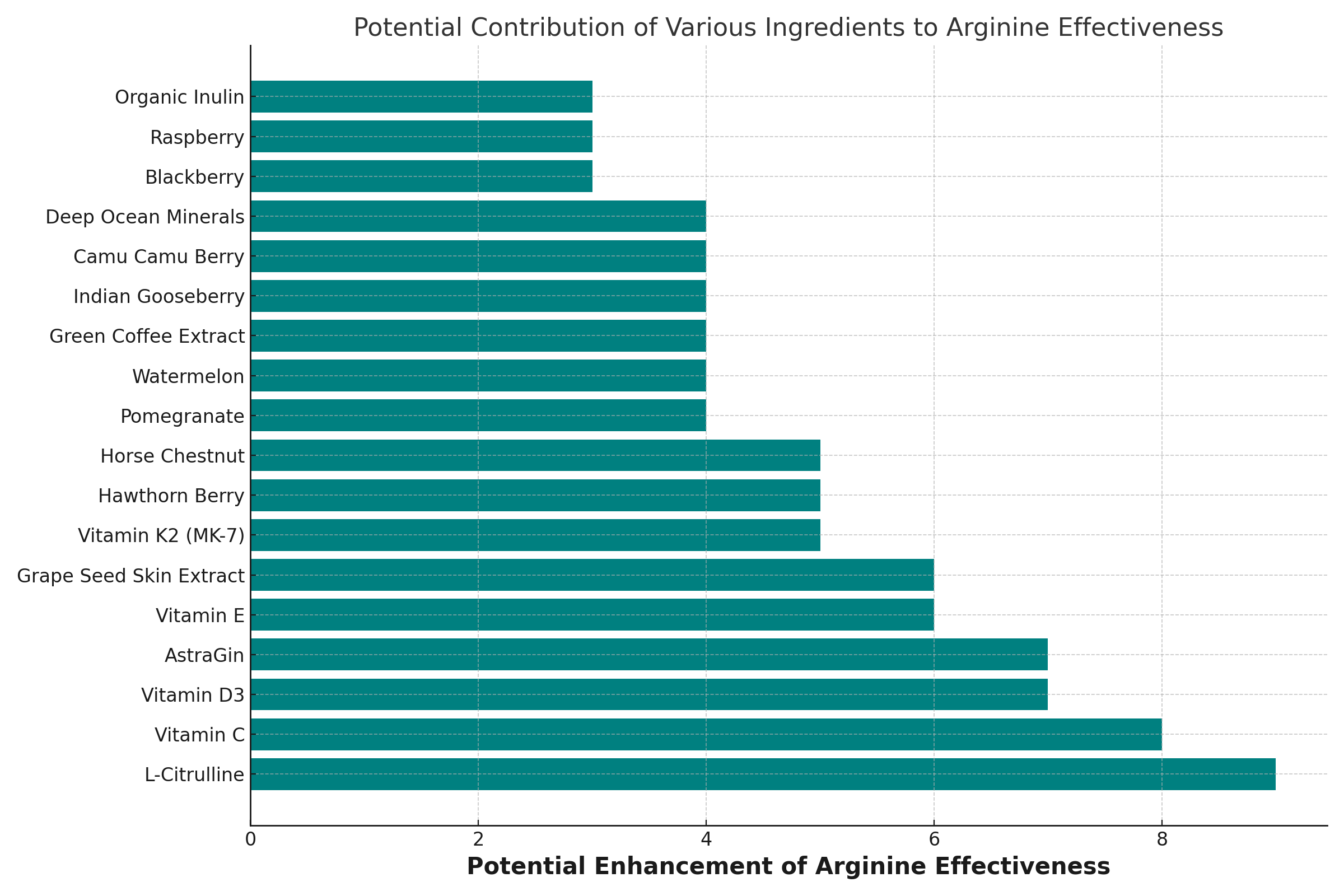
Stop Taking Arginine Alone
- Vitamin C: Enhances nitric oxide production from Arginine by stabilizing it and reducing its breakdown.
- Vitamin D3: Works synergistically to support cardiovascular health and may enhance the effectiveness of Arginine. Vitamin D also helps your body produce more NOS.
- Vitamin E: Protects cells from cellular stress, potentially enhancing Arginine’s effects on vascular health.
- Vitamin K2 (MK-7): May work with Arginine to support arterial health and flexibility.
- L-Citrulline: Converts to Arginine in the body, increasing Arginine levels and nitric oxide production.
- Pomegranate, Watermelon, Blackberry, Raspberry: These fruits are rich in antioxidants and other compounds that can support nitric oxide production and enhance the effects of Arginine.
- Hawthorn Berry, Horse Chestnut: Known for their vascular health benefits, potentially complementing Arginine’s cardiovascular effects.
- Green Coffee Extract, Indian Gooseberry, Grape Seed Skin Extract, Camu Camu Berry: These ingredients offer antioxidant support, which can synergize with Arginine’s health benefits.
- Deep Ocean Minerals: May provide trace minerals that support overall metabolic processes, including those involving Arginine.
- AstraGin: Known to enhance nutrient absorption, potentially improving Arginine bioavailability.
- Organic Inulin: A prebiotic fiber that can support gut health, possibly affecting Arginine’s absorption positively.
Cardiovascular Health
Arginine is well-known for its critical role in the production of nitric oxide (NO). NO is a vital molecule that influences various aspects of cardiovascular health as we have discussed above.
Nitric oxide acts as a vasodilator, meaning it relaxes the inner muscles of blood vessels. This causes them to widen and thereby improve blood flow and energy, etc.
This effect can lower blood pressure, enhance exercise performance, and reduce the risk of cardiovascular diseases. It even helps with some cognitive issues and diseases of the eye as well.
Despite its potential, the production of nitric oxide from arginine can be hampered when arginine is consumed alone. This is due to factors like enzyme availability, oxidative stress, and the presence of asymmetric dimethylarginine (ADMA). ADMA is a natural inhibitor of nitric oxide synthesis. In other words, if you stop taking arginine by itself, you get more of it. The results are better if your taking it with the right things.
Citrulline
The combination of arginine with citrulline is a strategy that can overcome these limitations. Combining the two can lead to more efficient nitric oxide production. This is yet another reason why you may want to top taking arginine alone. Citrulline is converted into arginine in the kidneys. It increases the plasma levels of arginine and also provides a more sustained release of arginine for nitric oxide production. Combining bypasses the competitive absorption issues in the gut. It also helps maintain higher levels of nitric oxide in the bloodstream. Combining the two enhanci cardiovascular benefits such as improved vascular tone, blood flow, and reduced blood pressure.
Vitamins E, C, and K2
These play supportive roles in enhancing nitric oxide production and ensuring its stability:
Vitamin E
This antioxidant helps protect nitric oxide from degradation via oxidatiion that can rapidly neutralize nitric oxide. It reduces the availability and effectiveness of NO in vasodilation. By reducing oxidative stress, vitamin E preserves nitric oxide levels. More NO means more cardiovascular benefits.
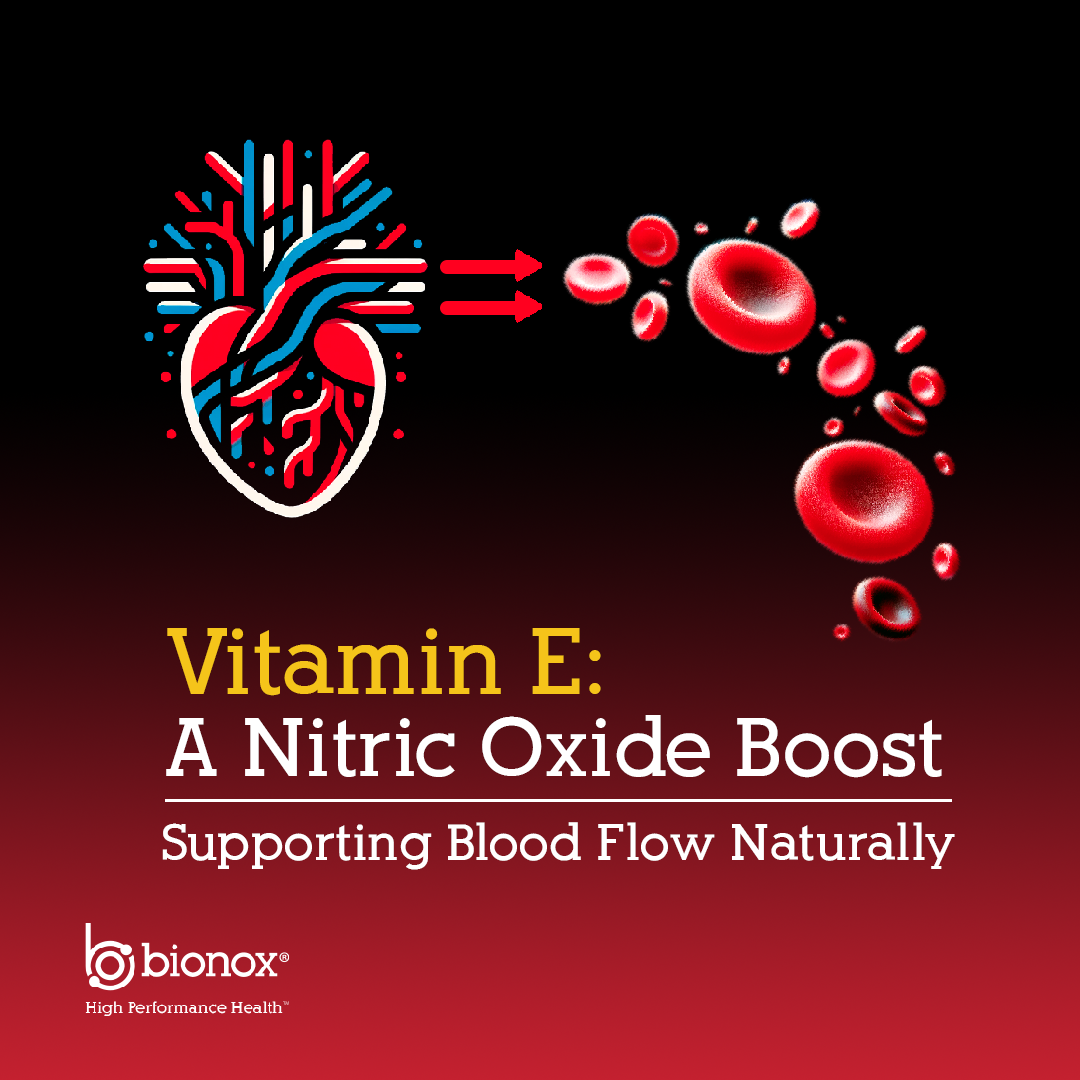
Vitamin C
Similar to vitamin E, vitamin C is an antioxidant that can synergize with arginine by stabilizing nitric oxide. Vitamin C reduces its breakdown in the bloodstream. C has also been shown to regenerate vitamin E, thus working together. These vitamins create a powerful antioxidant network that protects nitric oxide and enhances its effects on blood vessel dilation.
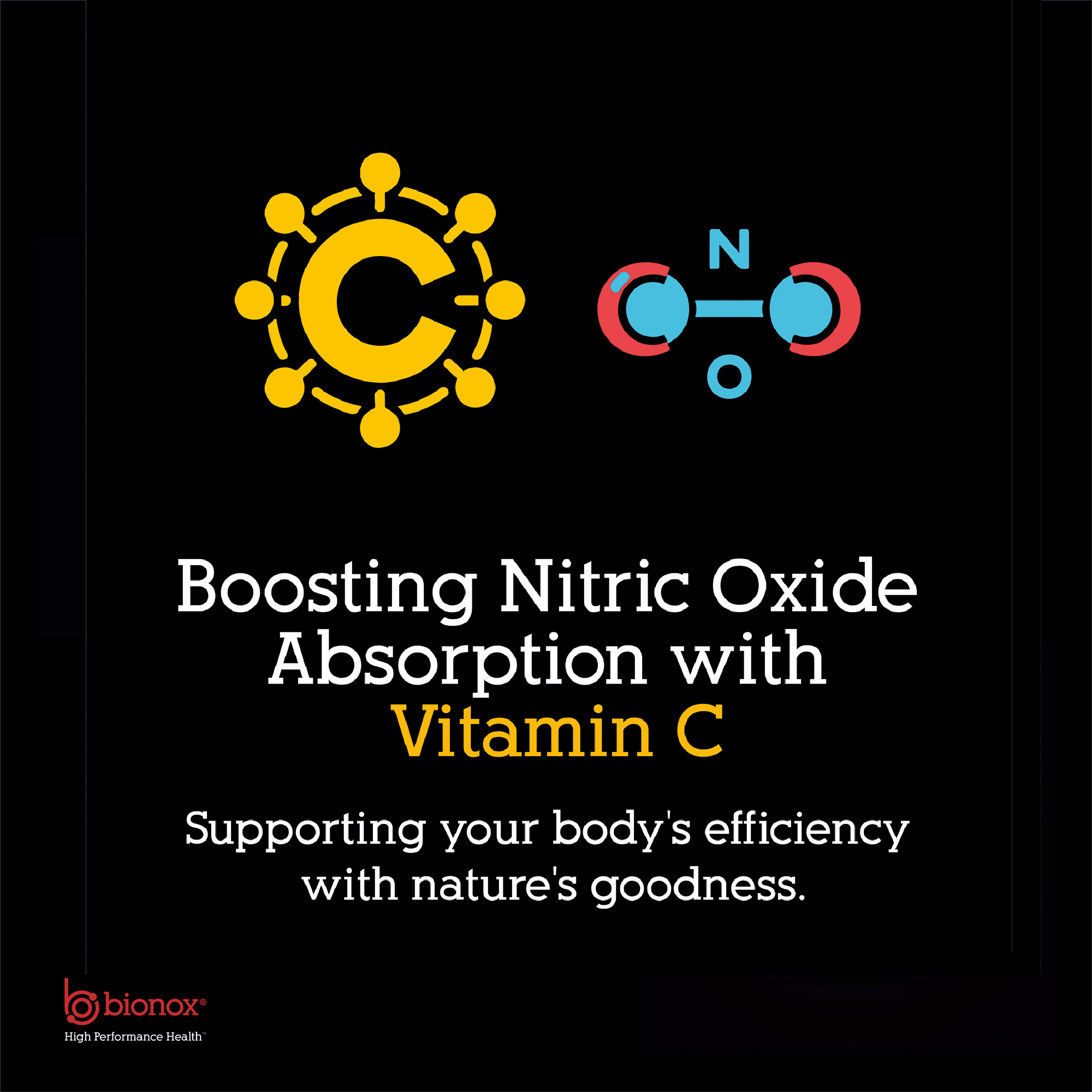
Vitamin K2 (MK-7)
While its role in nitric oxide production may not be as apparent as other vitamins, vitamin K2 contributes to cardiovascular health. It does so by preventing calcium deposition in the arteries. This action helps maintain arterial flexibility and function. There is emerging evidence that vitamin K2 may also support the endothelial function. This is is crucial for nitric oxide production and regulation. By promoting overall vascular health, vitamin K2 can indirectly support the optimal function of nitric oxide.
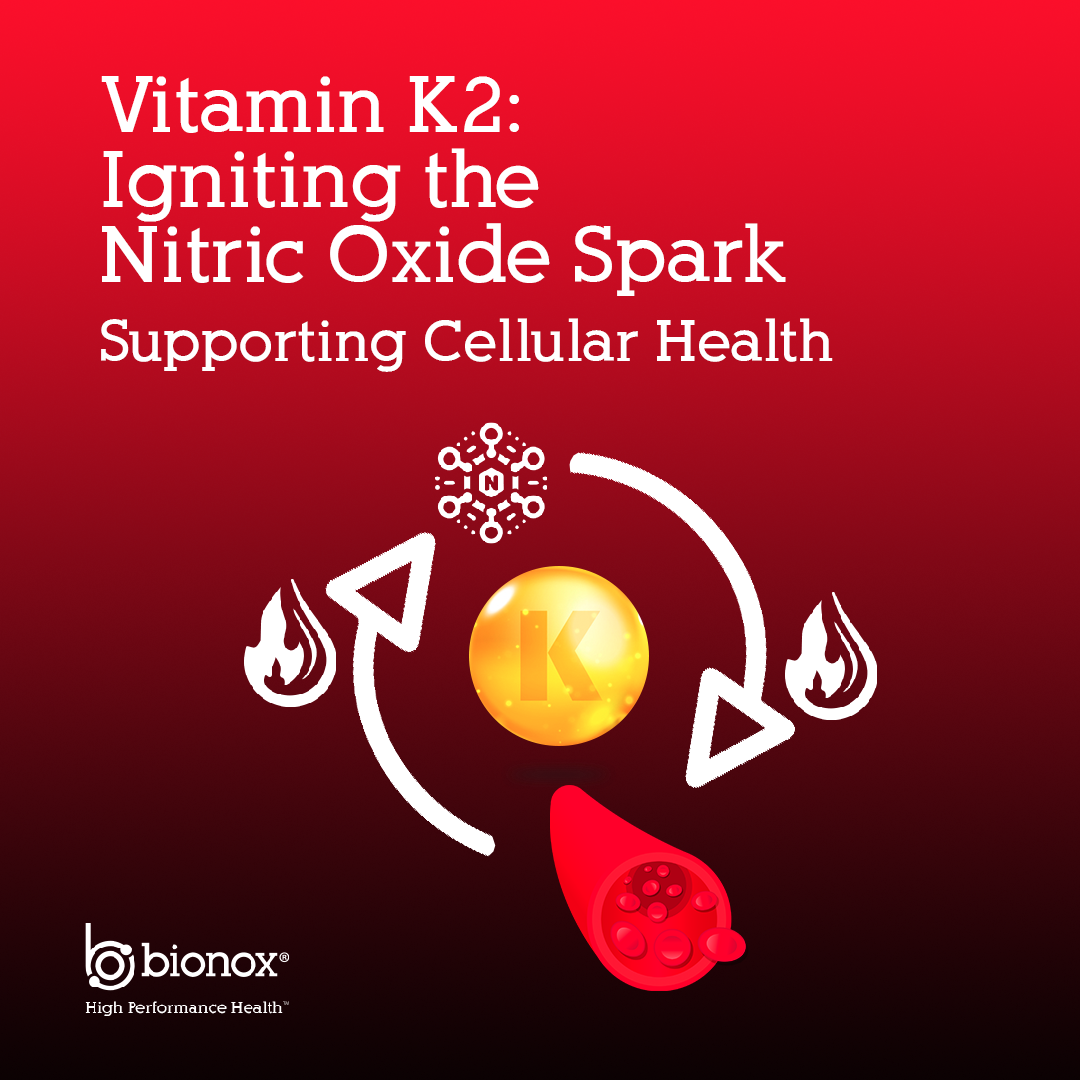
So, while arginine is a key precursor to nitric oxide its solo use can result in poor nitric oxide production. This is due to various physiological constraints, making it kind of a waste of money to take alone.
Combining arginine with citrulline and other vitamins can significantly enhance the production of nitric oxide. This strategic supplementation approach not only amplifies the cardiovascular benefits. It also supports broader health outcomes and benefits. This is done by ensuring efficient blood flow and nutrient delivery throughout the body and therefore more nitric oxide.
Reason 3: Inadequate Support for Vascular Health
Vascular health is fundamental to the overall well-being of the cardiovascular system, brain, gut, you name it. Healthy blood vessels are essential for the efficient transport of oxygen and nutrients to every part of the body. They also are vital for the removal of waste products, energy, vitality and pretty much everything.
Good vascular health also plays a critical role in preventing conditions such as atherosclerosis, hypertension, and PAD to name a few. While arginine is renowned for its capacity to enhance nitric oxide production and thus improve vasodilation and blood flow, relying on arginine alone might not offer comprehensive support for vascular health. This is because vascular health encompasses more than just the ability of blood vessels to dilate; it also includes the strength, elasticity, and integrity of the blood vessel walls.
Horse Chestnut
Enter the synergistic potential of combining arginine with horse chestnut (Aesculus hippocastanum), an herbal supplement known for its heart healthy properties. Horse chestnut can significantly enhance heart health. This amazing plant contains a compound called aescin. The active ingredients in aescin have been shown to strengthen capillary walls, reduce inflammation, and improve blood vessel tone. This can be particularly beneficial in conditions such as chronic venous insufficiency, where veins struggle to return blood to the heart efficiently.

The combination of arginine and horse chestnut works on multiple fronts to support vascular health. This is because of arginine’s role in nitric oxide production addresses the need for vasodilation and improved blood flow. Horse chestnut’s heart healthy and anti-inflammatory effects contribute to the structural health and functionality of the blood vessels.
Dual Action
This dual-action approach ensures that blood vessels are not only capable of adjusting their diameter for optimal blood flow but are also strong, resilient, and less prone to damage and inflammation.
Furthermore, the antioxidant properties of horse chestnut complement arginine’s cardiovascular benefits by protecting the endothelial cells lining the blood vessels. This protection can lead to stopping endothelial dysfunction, a precursor to atherosclerosis and other circulatory diseases. By stopping oxidative damage, the combination of arginine and horse chestnut supports the integrity of the inner veins, enhancing its capacity to produce nitric oxide and maintain vascular health.
In summary, while arginine alone offers significant benefits for enhancing nitric oxide production and improving vasodilation, it may not provide complete support for the multifaceted aspects of vascular health. Incorporating horse chestnut into a supplementation regimen that includes arginine can offer a more basic approach to maintaining and improving vascular health. This combination not only optimizes blood flow but also addresses the structural and functional needs of blood vessels, offering a comprehensive strategy for cardiovascular wellness.
Reason 4: Better Nitric Oxide Production with Vitamin D Supplementation: Stop Taking Arginine Alone
Vitamin D’s relationship with arginine extends beyond basic nutritional synergy, directly impacting the efficiency of nitric oxide (NO) synthesis and the activity of nitric oxide synthase (NOS), the enzyme responsible for NO production from arginine. This interaction is crucial for understanding how the combination of arginine and vitamin D can significantly amplify and promote cardiovascular health, immune function, and overall well-being.
Vitamin D has been shown to enhance the expression and activity of nitric oxide synthase, thereby increasing the conversion of arginine into nitric oxide and this increase in nitric oxide availability is vital for vasodilation, which improves blood flow and reduces blood pressure, supporting your heart.
More NO
The enhancement of NO production by vitamin D not only increases the heart health benefits provided by arginine but also supports the function of the inner lining of blood vessels, further protecting against arterial stiffness and cardiovascular disease.
The synergy between vitamin D and arginine in creating higher nitric oxide levels has broader health implications as well, especially for your immune system and bone health. Elevated NO levels can improve immune response by supporting the body’s defense mechanisms against diseases. Nitric oxide acts as a signaling molecule in the immune system, managing various processes involved in the immune response. Vitamin D, well-recognized for its role in supporting immune function and reducing inflammation, works in concert with arginine-derived NO to create a more effective immune response.
In terms of bone health, the improved blood flow resulting from increased nitric oxide production ensures that nutrients essential for bone maintenance, including calcium and phosphate, are efficiently delivered and utilized in the body.
Calcium Absorption
Vitamin D plays a direct role in calcium absorption and bone mineralization, making its combination with arginine a strategic approach to supporting skeletal health and heart health.
Arguing for the effectiveness of taking arginine with vitamin D rests on understanding these mechanisms as well as vitamin D’s ability to increase nitric oxide synthase and increase nitric oxide production from arginine. This provides a compelling reason to combine Vit D for improved health outcomes. This synergy not only enhances cardiovascular benefits by improving vascular function and reducing blood pressure but also supports robust immune function and contributes to the maintenance of healthy bones.
The combination of arginine and vitamin D offers a potent approach to health supplementation, with vitamin D significantly enhancing the conversion of arginine into nitric oxide and thereby amplifying the benefits of arginine supplementation. This partnership between vitamin D and arginine underscores the importance of a natural approach to supplementation, where the combined effects of nutrients are leveraged to achieve the best health outcomes.
Reason 5: Reduced Antioxidant Protection
Antioxidants play a pivotal role in safeguarding the body against oxidation, a condition characterized by an imbalance between free radicals and antioxidants. Free radicals are unstable molecules that can damage your cells, contributing to aging and various diseases, including cardiovascular disease, diabetes, and cancer, obviously things no one wants!
Antioxidants neutralize these nasty free radicals, thus protecting the body from damage. While arginine is known for its cardiovascular and immune system benefits, its antioxidant potential can be significantly improved when combined with vitamins E and C, both of which are powerful antioxidants. Also antioxidants make the nitric oxide molecule last longer, so they boost nitric oxides lifespan, and therefore effect! Yet another good reason you want to stop taking arginine by itself!
Vitamin E
Vitamin E is a fat-soluble antioxidant that protects cell membranes from cellular damage by reacting with free radicals, which prevents the propagation of free radical damage within the body. This vitamin is particularly effective in protecting against lipid peroxidation, a process that can compromise cell membrane integrity and function. By maintaining cell membrane health, vitamin E supports the optimal functioning of cells, including those involved in the synthesis and utilization of arginine.
Vitamin C, a water-soluble antioxidant, complements vitamin E by neutralizing free radicals in the aqueous environments of the body. Furthermore, vitamin C can regenerate oxidized vitamin E, thereby restoring its antioxidant capacity making this a synergistic interaction that enhances the body’s overall antioxidant defense system.
Vitamin C
Vitamin C also plays a crucial role in the synthesis of collagen, a protein essential for the maintenance of blood vessels, skin, and connective tissues. The presence of adequate vitamin C can thus support the structural health of blood vessels, ensuring a conducive environment for arginine’s cardiovascular benefits.
The combination of arginine with vitamins E and C offers a multi-faceted approach to combating oxidative stress and supporting your health. Arginine, through its role in nitric oxide production, can improve vascular health and support the delivery of nutrients, including antioxidants, to tissues throughout the body while, vitamins E and C directly neutralize free radicals and protect against cellular damage. This collective action increases the antioxidant potential of these nutrients and also enhances their individual benefits. These benefits being mostly related to cardiovascular health, immune function, and tissue repair.
Advocating for the combination of arginine with vitamins E and C is grounded in the understanding that optimal personal health outcomes are often achieved through synergistic nutritional strategies.
This approach leverages the complementary actions of arginine and antioxidants to fortify the body’s defenses against disease, thereby supporting overall health and well-being.
By incorporating these nutrients into a comprehensive supplementation regimen, you can harness a more potent antioxidant defense, offering broader protection against damage and its associated health risks.






